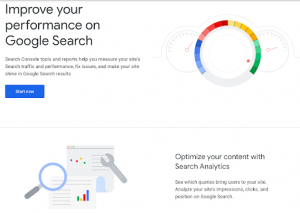Search engine optimization becomes more difficult to define every year. As SEO crosses borders with content marketing, web development and various other parts of your marketing strategy, it’s hard to draw the lines between them at times.
So we thought it might be a good idea to clarify the state of search optimization in 2017. There are five key ingredients to a successful SEO campaign and no single ingredient can work independently of the others. Understanding these five pillars will help you identify how you can achieve organic search success.
What are the five pillars of SEO?

SEO is a vague term these days and there’s a lot of confusion about what it does/doesn’t involve. The five pillars of SEO help clear this up by breaking down the key elements of search optimization after years of relentless change in the industry.
These days, SEO essentially means a combination of five things: relevance, authority, website health, competition and user experience.
1. Relevance
Google has transformed dramatically over the past five years and most of the changes relate to relevance. In 2013, the Hummingbird update replaced Google’s entire search algorithm with a more advanced system, which is now largely powered by the tech giant’s machine learning toolkit, including RankBrain.
Instead of matching volume of keywords and links, as it used to do, Google now aims to match user intent and the context of a search with the most relevant content available. Its search algorithm is getting better at understanding the meaning behind user queries every day and marketers need to prioritise user intent and context in the same way.
2. Authority
Relevance alone isn’t enough to get you among the top spots in Google. Search engines want to trust the information they provide and this is where authority comes into the five pillars of SEO. The more online authority you have, the more faith Google and other search engines will put in you when it comes to ranking results.
But how do search engines determine authority?
- Who links to you
- How frequently people mention you
- How many diverse citations you have
- Who you link to
The above signals tell Google that people trust you and inbound links remain one of the most powerful ranking factors today. This might change in the future but Google is yet to come up with a better trust factor than inbound links from high authority sites.
Note: Last year, Andrey Lipattsev stated that links, content and RankBrain are the top three ranking factors in Google’s search algorithm.
3. Website health
This is where the more technical side of SEO starts to come into play. By site health we mean the code-level fundamentals that make your website easy for search engines to discover and index.
These are the key areas you need to focus on:
- Broken links and pages
- Indexation issues
- Code integrity
- Structured data
The first two items on that list have always been important in SEO. Meanwhile, code integrity refers to the quality of the code behind your site – how clean, efficient and true to the latest standards it is – and this has become increasingly important over the years.
Then we have structured data, which is now an integral part of technical SEO. Structured data gives search engines vital information about your content so they’re better informed on how to index it. This is the technology that allows Google to distinguish product pages from articles, for example.
4. Competition
Logic says the more competitors you have, the harder it is to hit your marketing targets. The amount (and level) of competition you face, the higher you’ll have to bid on keywords, harder you’ll have to fight for top ranking positions and more strategic you’ll need to be with your pricing and special offers.
The important thing is to know how many competitors you have and who they are – but this isn’t always as obvious as you might think. For starters, your main rivals in business and your main rivals in search may not be the same companies. It’s important you’re able to make this distinction, spot any irrelevant businesses you’re competing against in search and keep track of any new rivals that emerge.
5. User experience
Aside from relevance, the other big change behind how Google ranks results has been an emergence of user experience factors over the past few years. This has been largely driven by the rise of mobile, which is fundamental to Google’s plans for the future. So it’s no surprise to see the search giant pay more attention to user experience and performance.
Here’s a quick summary of user experience factors that can affect your search ranking:
- Loading times
- Mobile-friendliness
- Navigation
- Ease-of-use
- Use of popups and other ads
These UX signals will have a direct impact on your search ranking but creating a solid user experience also has a knock-on effect on other signals Google uses to determine your place in the SERPs. Solid UX should also mean the following:
- Lower bounce rates
- More time on site
- Higher page visits per session
- More return visits
- More shares, links and citations
There are other potential influences UX could have on your search ranking but those points listed above are the ones either known or widely accepted. Not to mention good UX removes a ton of conversion barriers that will otherwise prevent people from buying into your brand.
So that’s the state of SEO in 2017 broken down into its five key elements. This should make it easier to understand and explain what it takes to run a successful search optimisation campaign in 2017.
This also gives you a good idea of where SEO overlaps with content, design and the other marketing essentials. Power your SEO efforts with these five pillars and you’ll have a competitive advantage over competitors who only take care of one or two elements.
Digital & Social Articles on Business 2 Community(87)
Report Post





